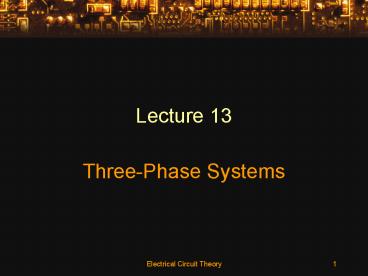ThreePhase Systems - PowerPoint PPT Presentation
1 / 18
Title:
ThreePhase Systems
Description:
Voltages in a Wye Circuit ... Currents for a Wye Circuit. Line currents are the same as phase currents. ... Active Power to a Balanced Wye Load. P = V I cos. PT ... – PowerPoint PPT presentation
Number of Views:1543
Avg rating:5.0/5.0
Title: ThreePhase Systems
1
Lecture 13
- Three-Phase Systems
2
Single-Phase AC Voltage Generation
3
Three-Phase Voltage Generation
- Three-phase generators have three sets of
windings and produce three ac voltages. - The windings are placed 120 apart, so the
voltages are three identical sinusoidal voltages
120 apart. - A set of voltages such as these are said to be
balanced. - If you know one of the voltages, then the other
two are easily determined.
4
Four-Wire Systems
- All three loads have a common return wire called
the neutral. - If the load is balanced, the current in the
neutral is zero and can be removed. - In practice, this current may not be exactly
zero, but is very small. - Because this current is so small, this wire can
be thinner than the others.
5
Three-Phase Relationships
- Line voltages are voltages between lines either
at the generator (EAB) or at the load (VAB). - Phase voltages are voltages across the phases.
For a Y load, phases are from line to neutral
for ? load, the phases are from line to line. - Line currents are currents in the line
conductors. - Phase currents are currents through the phases.
For a Y load the two currents are the same.
6
Voltages in a Wye Circuit
- For a balanced Y system, the magnitude of
line-to-line voltage is times the magnitude
of the phase voltage. - Each line-to-line voltage leads its corresponding
phase voltage by 30. - The line-to-line voltages form a balanced set.
7
Currents for a Wye Circuit
- Line currents are the same as phase currents.
- In a balanced or 4-wire system Ia Van/Zan
- If the load is balanced line currents form a
balanced set and if you know one current, you can
determine the other five currents by inspection.
8
Currents for a Delta Load
- In a balanced delta, the magnitude of the line
current is times the magnitude of the phase
current. - Each line current lags its corresponding phase
current by 30. - Given any current in a balanced, three-phase
delta load, you can determine the remaining
currents by inspection.
9
Power in a Balanced System
- To find total power in a balanced system,
determine the power in one phase, then multiply
by three. - Use the ac power formulas previously developed.
- Since magnitudes are the same for all three
phases, simplified notation may be used.
10
Active Power to a Balanced Wye Load
- P? V?I? cos ??
- PT 3P? 3V?I? cos ??
- PT VLIL cos ??
- P? I?2R?
- PT 3I?2R?
11
Reactive Power to a Balanced Wye Load
- Q? V?I? sin ??
- QT VLIL sin ??
- Q? I?2X?
- The unit is VAr.
12
Apparent Power to a Balanced Wye Load
- S? V?I?
- ST VLIL
- S? I?2Z?
- The unit is VA
- The power factor is
- pf cos ?? PT/ST P?/S?
13
Power to a Balanced Delta Load
- The power formulas for the ? load are identical
to those for the Y load. - In all these formulas, the angle ?? is the phase
angle of the load impedance. - You can also use the single-phase equivalent in
power calculations. The power will be the power
for just one phase.
14
Measuring Power in Three-Phase Circuits
- Measuring power to a 4-wire Y load requires three
wattmeters (one meter per phase). - Loads may be balanced or unbalanced.
- The total power is the sum of the individual
powers. - If the load could be guaranteed to be balanced,
only one meter would be required, its value
multiplied by 3.
15
Measuring Power in Three-Phase Circuits
- For a three-wire system, only two meters are
needed. - Loads may be Y or ?.
- Loads may be balanced or unbalanced.
- The total power is the algebraic sum of the meter
readings.
16
Unbalanced Loads
- Unbalanced four-wire Y systems without line
impedance, use Ohms law. - Three-wire and four-wire systems with line and
neutral impedance require the use of mesh
equations. - One of the problems with unbalanced loads is that
you get different voltages across each phase of
the load and a voltage between neutral points.
17
Power System Loads
- Residential and business customers require only
single-phase power. - Industrial customers may require single-phase and
three-phase systems. - Therefore, there is a need to connect both
single-phase and three-phase loads to three-phase
systems.
18
Power System Loads
- The utility tries to connect one-third of its
single-phase loads to each phase. - Three-phase loads generally are balanced.
- Real loads are seldom expressed in terms of
resistance, capacitance, and inductance. - Instead, real loads are described in terms of
power, power factors, etc.

